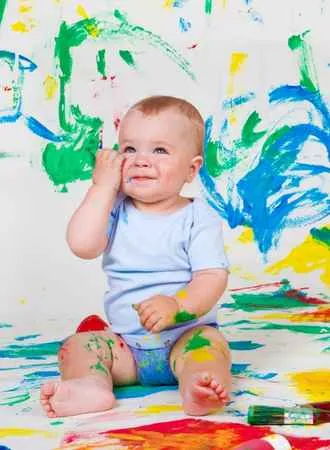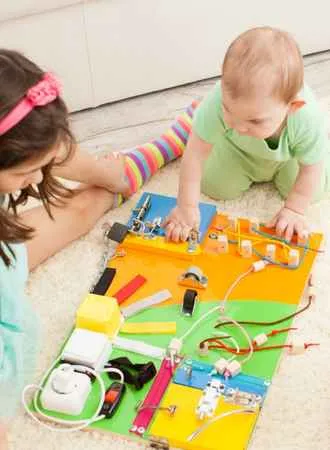Babies are the cutest little angels with their tiny fingers and cute toes. But there is little time to admire their cuteness as they keep you occupied with a whole range of important tasks.
Feeding, cleaning, and sleeping can take up a lot of time out of a parent’s and a baby’s day. However, a baby needs to engage in sensory play to develop their senses, and as a parent, you need to let your baby explore the world of texture, sound, colors, etc.
To help your baby develop essential skills from an early age, we have some sensory play ideas that are both fun and helpful.
Sensory play helps your 6-month-old’s cognitive, emotional, and physical development.
Sensory play activities can include exploring textures, colors, and sounds, and can help develop fine motor skills, communication, and visual abilities.
Some fun and easy sensory activities for 6-month-olds include rainbow spaghetti, sensory bins, play peek a boo and tactile play.
20 Sensory Activities for 6-Month-Olds
- Gel Exploration: Fill a ziplock bag with hair gel and seal it. Let the baby squish and explore the texture with their little hands.
- Rainbow Rice Play: Create rainbow rice by dyeing rice with food coloring and let the baby feel the grains.
- Edible Baby Sand: Use edible sand for a safe and tactile experience.
- Ice Cube Exploration: Place ice cubes in a bowl and let the baby touch and feel the cold sensation.
- Cloud Dough Creations: Introduce the baby to cloud dough, a soft and moldable texture.
- Water Bottle Shake: Fill a water bottle with colorful beads or rice. Seal it and let the baby shake and listen to the sounds.
- Coconut Oil Massage: Use coconut oil to give the baby a gentle massage, stimulating their sense of touch.
- Sensory Exploration Basket: Create discovery baskets filled with different materials from around the house for the baby to explore.
- Jello Dig: Create a jello dig with edible jello for the baby to squish and explore.
- Cotton Ball Play: Let the baby play with cotton balls, feeling their soft texture.
- Minimal Mess Painting: Place some non-toxic paint in a ziplock bag and tape it to a window or floor. Let the baby squish and move the paint around inside the bag.
- Sensory Activity with Food : Use a food processor to create different textures of foods for the baby to touch and taste.
- Happy Toddler Playtime: Set up a play area with different textures for the baby to crawl over and explore.
- Hand Eye Coordination Games: Use soft toys to play peek-a-boo, helping develop their hand eye coordination.
- Little Fingers Exploration: Set up a tray with a variety of textures for little fingers to explore.
- Gross Motor Skills Movement: Encourage the baby to reach and grab for hanging toys, developing their gross motor skills.
- Enjoy Watching Mobiles: Hang colorful mobiles above the baby’s crib and let them enjoy watching the movement.
- Sensory Sound Bottles: Fill bottles with different materials like rice, beads, and bells. Seal them and let the baby shake them to hear different sounds.
- Household Items Exploration: Allow the baby to explore safe household items like wooden spoons, soft cloths, and silicone kitchen tools.
- Play Games: Play peek-a-boo or hide and seek with toys to help build their attention span.
Why Is Sensory Play Important for 6-Month-Old Babies?
One of the most important responsibilities that you have as a parent is to help your baby grow and develop skills along the way. As your child’s language and motor abilities grow, the sensory activities focus on games that appeal to their senses.
It not only helps foster social relationships and encourages exploration, but it also aids cognitive development.
Moreover, sensory play-related activities like hide and seek, color matching, transferring things, etc., help develop imagination, and babies learn many things on their own.

How Do Sensory Activities Work?
Sensory activities primarily introduce texture, temperature, color, noise, and other types of sensory perceptions into your baby’s playtime.
Introducing developmental activities for babies 6 months old is a good choice for their brain development. It lets them interact more and is fun for both the baby and the parents.
- Communication Development
When babies smash on alphabet keyboards, they gradually learn the sounds of the words and try to make the same noises.
While actual words are hard for your little ones, sounds like these can help them communicate more.
Moreover, sounds from different things, like banging on pots and playing with spoons, can give babies a sense of communication.
- Movement Development
Children explore the textures and shapes of objects by touching and moving them. The little muscles, mostly in their fingers and hands, are worked out and fine-tuned as they squeeze, twirl, and pour. The same happens when they dip their little feet in the water or play with sand. Their muscle memory starts to develop and helps them in their growing years.
- Visual Development
Through play, kids grow visually. They get a sense of color and how they look when painted.
As they experiment with movement, play with lights, and mix paint colors, kids develop their coordination and gain an understanding of cause and effect. That is why introducing hand painting and art into your baby’s playtime is essential.

Different Types of Sensory Activities That Work Best for 6-Month-Old Babies
Babies grow up so fast in just a blink of an eye. As a parent, you would want to cherish them and also take proper care of their developmental skills. Sensory activities help to reach that goal and start the learning process from a young age because young minds develop fast.
But, sometimes, finding fun things to do with a 6-month-old baby can be challenging. Your baby might easily lose interest or focus on a game or a book. That is why you need to use your creative skills and craft DIY activities to keep 6-month-olds engaged in learning and developing while performing fun activities.
Our list of sensory play ideas for babies is engaging, fun, and easy to make for your little one.
Rainbow Spaghetti
A colorful way to engage your sweet baby in sensory play is rainbow spaghetti. It’s also great for babies who keep putting everything in their mouths. This is a little messy but fun and helpful. All you need is four packages of spaghetti and food coloring.
Step 1: Cook the spaghetti as usual in water.
Step 2: Then rinse it with cold water.
Step 3: Now add a bit of oil and water mixture to the spaghetti and toss it around.
Step 4: Now divide the spaghetti into the colors you want and add a few drops of food color. Mix it properly and let it dry for at least 2 hours.
Now, your baby has something edible to play with. The texture and color of the spaghetti will help them develop creative skills, and trying to hold them with their hands will help with their movement skills. Make sure to place a play mat underneath your baby to avoid getting spaghetti stains everywhere. Moreover, you can easily clean them off with a semi-wet cloth.
Copycat Play
Children love to imitate their parents, and it is the same when they are babies.
Copycat play is an imitation game that lets your baby learn language skills and improve visual perceptions.
The copycat game is very flexible because your baby can enjoy it lying on their tummy, back, or just sitting. You can make sounds and funny facial expressions to them and see if they copy you. Try blowing raspberries, sticking your tongue out, or making simple syllable sounds like mama, dada, etc.
You can also involve your whole family and develop your baby’s social connection with them. It will also help your baby bond with different family members. Always make sure to praise your baby when they copy something; it will encourage them to do it more often.

Sensory Bags
Sensory bags are a great way to introduce babies to different temperatures and textures. It is a mess-free method for parents because babies make a big mess with everything, which may often be cute but keeping the house clean feels peaceful.
All you need are ziplock bags and anything that is sensory. You can fill the bag with watercolor paint, shaving cream, colorful whipped cream, pom poms, seeds, ice, or other similar materials. But make sure you interact with your baby and help them know what it does to aid the sensory learning. Also, make sure you seal the bag tightly; use tape if necessary. It can be more helpful if you stick the bag to a piece of cardboard.
Water Play
Every baby is excited to play in or with water. So, water play is a perfect sensory activity for babies to enjoy while learning gross motor skills. But it is always important for a parent to be present because they will need supervision.
You can fill up a bathtub or a baby pool with not more than a few inches of water and let your baby splish-splash in the water. You can join in on the fun and even put some of your baby’s favorite toys in it. Then your baby will think about how to grab the toys and eventually try to do it, improving their visual and motor skills.
On top of that, you will get to enjoy some beautiful moments enlivened by your baby’s smiles and cuteness. For another sensory play idea you can add texture or colour to the water play.
Finger Painting
Who doesn’t love finger painting? But as babies are too young to understand not to put everything in their mouth, they will need a safe edible option apart from paint. Using the things in your pantry, you can easily make edible paint at home. Moreover, it’s better to be safe than sorry when it comes to baby play.
To make edible paint, you only need sugar, salt, water, cornflour, and the following method.
Step 1: Make cornflour slurry and add it to a pot.
Step 2: Heat it until the mixture is thick and slimy.
Step 3: Cool off the mixture and then separate it into separate containers.
Step 4: Now add the food coloring of your choice and mix together well until you get a colorful edible paint.
With your edible paint now complete, you can prepare an art nook in the house for your little one. You can also sit them on their high chair and give them the paint (most montessori style high chairs allow activities). Your babies will enjoy playing with the different colors and understanding patterns.
Texture Sensory Board
If you can’t wait to introduce your baby to various textures, the texture sensory board offers a lot. It is easy to make, inexpensive, and will keep your little sunshine occupied for hours. But as usual, you should supervise everything. You must also interact with your baby while playing with it.
To make the sensory board, you will need cardboard, diaper wipes lid, pom poms, felt paper, bubble wrap, uncooked pasta, sequence, and anything you think your baby will enjoy.
Cut everything down to fit in the lid, then glue them onto the cardboard. Make sure you don’t use too much glue or too little even, as one might be harmful, and the other can lead to a choking hazard. Then attach the lid to it and make sure there is no open space, and you are done.
Now you have a sensory board your baby can play with which is so much fun, and after they are done, you can just close it and put it away.

Noise Identification Play
Babies need to get accustomed to new sounds at an early age. It helps baby’s brain identify new sounds around them and builds sound perception skills.
Try to talk to your baby as much as possible; they will slowly understand your expressions and language. You can also give them pots and pans to play with, as they will use them to make noise.
You can find alphabet keyboards in toy stores if you want a pleasing sound. This will let your baby identify sounds while enjoying smashing the keyboards.
Another ideal option is to take your baby out in a park to surround them with the sound of nature. The birds, wind, and people talking will make your baby more social and enhance their ability to understand and identify different sounds.
Balloon Kicking
Your baby will love the game of balloon kicking. It will help with their movement, visual tracking, and concentration skill. The game is fun, and your little one can enjoy it when they are lying on their back.
All you will need is a balloon with a string attached to it to introduce this game.
Lightly tie the balloon string on your baby’s leg and make sure the balloon is at the reach of their feet. If you don’t want to tie it to their leg, you can also tie it to anything closest to their little feet. Then watch as your baby tries to kick the balloon and enjoy themselves. Their little laughs will fill your heart and help them develop sensory skills.

Focusing on the Best for Growing Babies
When a baby enters anyone’s life, everything changes. Of course, there will be sleepless nights, crying, and frustrating scenarios, but your baby will give you some of your best moments and memories too. They will learn to walk, ride a bike, eat by themselves, and go through any number of milestones before your eyes.
So, when they are still babies, you should interact with them, introduce them to sensory activities, and give them all the love to help them become kind, compassionate, confident, and well-rounded human beings!
Key Takeaways on the Best Sensory Activities for 6 month old
- Sensory play is an important aspect of a baby’s development, especially at the age of 6 months.
- Sensory activities can help with visual, motor, and creative skill development.
- Parents can use the ideas mentioned in the article to engage their babies in fun and stimulating activities that will aid in their growth and development.
- It is important to remember that every baby is unique, so it’s important to observe your baby and tailor the activities to their interests and abilities.
- Sensory play is not only beneficial for babies but also a great bonding opportunity for parents and their little ones.
- Sensory play can be incorporated into daily routine and make it fun for both the baby and the parent.
FAQs on Sensory Play for 6 month olds
How do I mentally stimulate my 6 month old?
- Talk to them: Babies at this age are beginning to understand language, so talking to them and using simple words can help with language development. You can also read to them, sing songs, and make silly sounds to engage their auditory senses.
- Play games: Simple games such as peek-a-boo, pat-a-cake, and hide-and-seek can help with cognitive development and problem-solving skills.
- Encourage movement: Babies at this age are starting to become more mobile, so encouraging them to move around and explore their environment can help with physical development and coordination. Tummy time is essential for sensory development.

What is the best play activity for a 6 month old to provide tactile stimulation?
- Sensory bins: Fill a container with different textures such as rice, beans, or sand, and let your baby explore the different textures with their hands. You can also add small toys or objects for them to discover.
- Play dough: Play dough is a great way to provide tactile stimulation and fine motor development. You can make your own play dough or buy it from the store. You can also add different textures like small pasta or beads to the play dough to make it more interesting.
- Finger painting: Finger painting is a great way to provide tactile stimulation and it’s also a fun activity for babies to explore different textures and colors. You can use non-toxic paint or make your own paint with cornstarch, food coloring and water.
- Water play: Fill a small container with water and add different toys like measuring cups, spoons, and plastic cups for your baby to explore.
- Textured balls: providing a variety of textured balls such as a rubber ball, a fur ball or a squeaky ball can provide an interesting tactile experience for a baby.
- Fabric books: Fabric books are perfect for babies to explore different textures. They are safe, easy to clean and the different fabrics can be interesting for the baby.
When should I start baby sensory activities?
It is generally recommended to start baby sensory activities from birth. Sensory experiences are essential for a baby’s cognitive, emotional, and physical development. As soon as a baby is born, they are able to perceive a wide range of sensory information through their eyes, ears, nose, mouth, and skin. This is why it is important to provide a variety of age-appropriate sensory experiences to help babies learn and develop.
For example, even a newborn can start to experience the world through their sense of touch by being cuddled, massaged, and held. They can also start to explore their environment through their sense of vision and hearing by looking at high-contrast images, and listening to different sounds like music, lullabies or nature sounds.
As your baby grows, you can continue to provide them with new and age-appropriate sensory experiences, such as playing a fun game with different textures, using different objects for exploring light and color, doing messy play baby activities and listening to different types of music. It is important to remember that every baby is unique, so it’s important to observe your baby’s preferences and tailor the activities to their interests and abilities.




